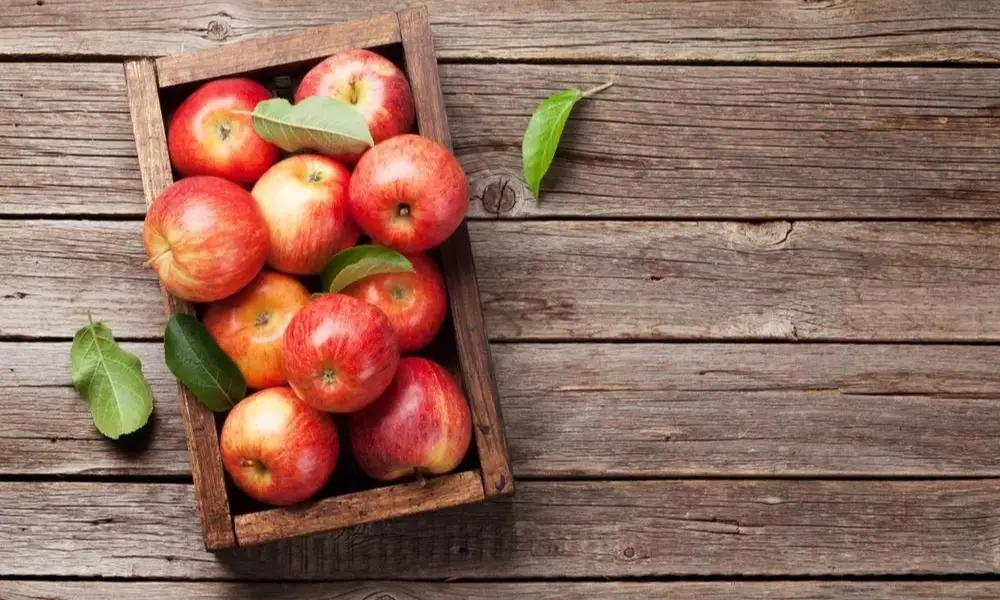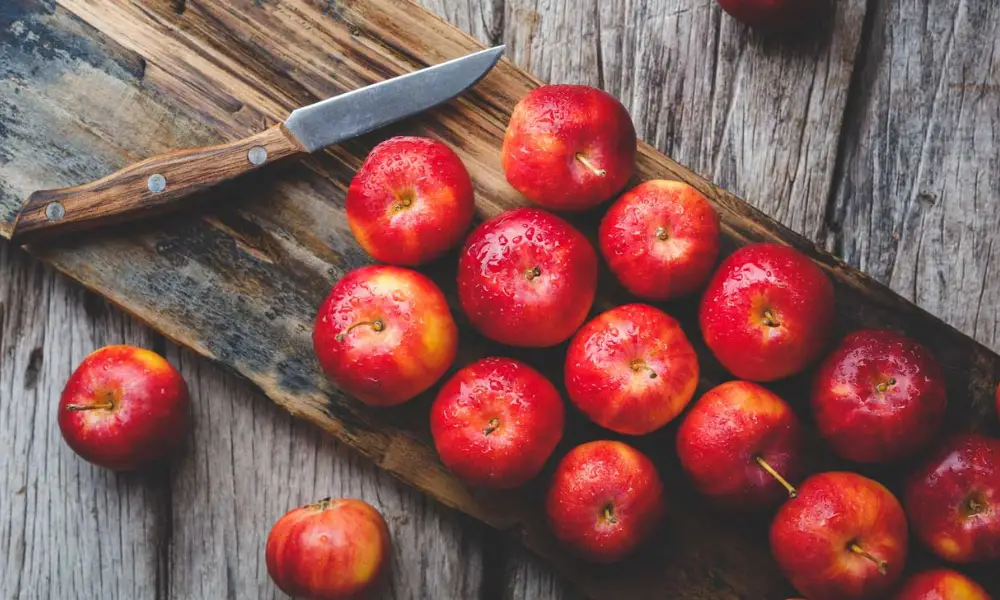If you’ve ever gone apple picking in the fall and brought a bushel of apples home, you know how difficult it can be to use them all. Apples can be preserved in various ways to keep them tasty for weeks or even a year.
Apples can be kept in the refrigerator in a few different ways. First, they shouldn’t be kept next to things that could ripen them too quickly. Also, keep apples away from onions and bananas when keeping them. Additionally, avoid stacking fruit on top of one another to prevent the development of brown stains on the fruit.

How to Store Apples?
To properly store apples for use in a few weeks, go by the following instructions:
Constantly leave apples out in the open. Whole apples will keep for a week if put on the counter and out of the sun.
Apples should be kept in the crisper drawer. Apple whole can be kept for up to six weeks in the refrigerator’s crisper drawer. The apples should be wrapped in a wet paper towel or put in a plastic bag with holes to keep them fresh. The ethylene gas that apples emit will cause other fruits and vegetables to ripen more quickly, so keep apples separate from other produce.
On apple slices, squeeze some lemon juice. For three to five days, cut apples will stay in the refrigerator. To prevent the apple slices from rusting, squeeze some lemon juice over them.
Long-Term Store Apples
The following long-term storage solutions are worth thinking about if you want to keep apples for a few months:
Store your apples in a cold, dark area. Those are the ideal conditions for apples because they are chilly and dark. Traditionally, the best way to store apples long-term was in a root cellar.
If you don’t have a root cellar, you can still use your garage or unheated basement as a place to store apples as long as it is kept cool and has good airflow.
Before storing the apples, wrap them. Wrap each whole apple in paper before placing it gently in a box to store it for a long time. You won’t need to take the wrapped apples out of the paper, but if your home is dry, you might want to spray them frequently. Once a week, check the apples and get rid of those that show signs of deterioration. These apples can be cooked with or eaten raw.
Apples should be frozen. The apples can also be frozen; they can last up to six months in the freezer. To keep the apples from browning, toss them in lemon juice, then pat them dry. The sliced apples, or even whole apples, can be frozen overnight. Transfer them to a freezer bag for long-term storage after flash freezing. Remember that freezing apples will result in some of their texture and freshness being lost. Frozen apples work best for dishes that call for cooked apples, such as apple pie, apple butter, or apple sauce.
How to Pick Storage-Friendly Apples?
Make sure to select the best apples for long-term storage when storing apples, and consume any that will spoil them as soon as possible. When choosing apples to store, keep the following in mind:
Distinguish the bushel of bad apples from it. Use any apples with soft spots, bruising, or other flaws first. Apples with bruises release ethylene gas, accelerating the ripening and decay of nearby apples. Avoid storing a bushel of apples that have been damaged.
Store tart, crisp apples. The finest apples for long-term storage are crisp and sour, with thick skin. Golden Delicious and other sweeter apples won’t keep as long. Granny Smith, Fuji, McIntosh, Winesap, Honeycrisp, Northern Spy, and Rome apple cultivars can last six months or longer.
Look for apple stems. Apples with stems remain fresher longer than those without. Decomposition can occur in apples with severed stems as a result of microbes.
Buy fruity apples. Apples from the grocery store have already been preserved for a considerable amount of time, which reduces the amount of time you can store them at home. Get the apples directly from an apple tree or a farm if you want to store them for a long time.
How Can I Tell if an Apple is Bad?
Bad apples will have softer flesh than usual and wrinkled or gritty skin. Browning and discolouration indicate that an apple is bad but don’t forget to look i. ide. Additionally, check sure the apple has a rotten or sour odor. It’s not pleasant to smell decaying apples. A fresh apple has smooth, vibrant skin that smells pleasantly fragrant. There won’t be any lumps, soft patches, or spots of varying colors. When you bite into them, they are both crunchy and juicy.
To prevent rotting, apples should be checked often.
One bad apple can ruin a whole bunch of them, so if you’re not going to consume the whole batch at once, you should remove it from the group.
Apples release ethylene gas, which has the effect of increasing both the ripening and rotting processes in other produce. Fruit should always be washed and dried before cooling.
Because breathing in mold spores can trigger allergic responses and respiratory problems, it is best to avoid sniffing the fruit. The fruit will also be unsafe for food due to the fragrance, which may even cause cancer! And apples with mold damage have additional issues.
Here are a few signs that an apple is starting to rot:
Bruising or soft patches
Dark blemishes and creases in the skin
A liquid seeps through its skin, has a mushy texture, and tastes bland or gritty.
Apples that are soft or otherwise exhibit other indications of aging should be discarded because moisture under the skin may indicate contamination.
How Can Apples Have a Longer Shelf Life?
You must preserve apples at home properly if you want them to last longer.
To help keep your apples as fresh as possible, try the following:
Before cooking and eating your apples, kindly don’t wash them.
Wait to cut into your apples until you are ready to consume them. Exposure to oxygen can hasten the oxidation process and cause them to spoil.
Please place entire apples in the refrigerator’s crisper drawer to keep them fresher for longer rather than storing them in the pantry or on the counter.
Cut apple slices in half and combine with 1 cup (240 ml) of water and one teaspoon (5 ml) of lemon juice. This will lessen the oxidation-related browning that occurs naturally.
To prevent the spread of ethylene gas, which can cause other apples to be brown, wrap each apple in plastic or a paper bag.
Reference: Antioxidant activity of fresh apples
What Dangers Can You Face If You Eat Expired Apples?
Even while eating apples that are getting older isn’t necessarily bad, mold can develop on apples just like on other fresh foods.
Mold is caused by microorganisms, making some people sneeze or have breathing difficulties. Mycotoxins, produced by some microbes, are responsible for many food-borne diseases.
Mycotoxin, patulin, is produced by the Penicillium Expansum species and can grow on apples. Consuming excessive amounts of patulins increases your risk of developing cancer, makes you ill and makes ulcers bleed.
Additionally, mycotoxins can alter the microorganisms in your stomach, harming your immune system and increasing your risk of contracting additional ailments.
How Long are Apples Good for?
An apple’s shelf life is influenced by when it was picked, how it was stored after that, and whether it was washed, chopped, or cooked. Before reaching supermarket shops, several fruit distributors preserve apples in ways that keep them crisp for months. Cleaning apple bins frequently involves the use of a gas called 1-methyl cyclopropane.
The most important factors for consumers to consider while storing apples at home are the temperature and whether or not they have been cleaned or chopped. Because 1-MCP inhibits the effects of ethylene, a colorless gas that accelerates ripening, apples in storage don’t ripen. But as soon as the apples are removed from these circumstances, the ripening process resumes.
Conclusion
Apples should be stored in a cool, dark, frost-free place. Ideally, the temperature should be at or below 45 degrees. In winter, use a root cellar, but shelves in your garage or frost-free shed are also suitable storage options. Do not freeze apples, as it will damage their internal cellular structure. As a result, when you thaw them, they will be mushy.
Another alternative to storing apples in a fridge is to place them in an insulated crate. You can line a crate or a cardboard box with insulation. The container should not be airtight but sufficiently airtight to regulate the temperature and airflow. Straw or perforated plastic liners work well. However, do make sure the apples don’t touch each other.

